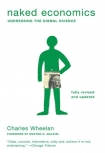Naked Economics by Wheelan, Charles (spanish books to read .txt) 📕

Read free book «Naked Economics by Wheelan, Charles (spanish books to read .txt) 📕» - read online or download for free at americanlibrarybooks.com
Read book online «Naked Economics by Wheelan, Charles (spanish books to read .txt) 📕». Author - Wheelan, Charles
Nonetheless, Prime Minister John Major declared emphatically that his “over-riding objective” was to defend the pound’s targeted value in the ERM, even as that task seemed ever more difficult. Soros called the government’s bluff. He bet that the Brits would eventually give up trying to defend the pound, at which point its value would fall sharply. The mechanics of his billion-dollar day are complex,* but the essence is straightforward: Soros bet heavily that the value of the pound would fall, and he was right.2 On September 16, 2002—“Black Wednesday”—Britain withdrew from the ERM and the pound immediately lost more than 10 percent of its value. The pound’s loss was Soros’s gain—big time.
International economics shouldn’t be any different than economics within countries. National borders are political demarcations, not economic ones. Transactions across national borders must still make all parties better off, or else we wouldn’t do them. You buy a Toyota because you think it is a good car at a good price; Toyota sells it to you because they can make a profit. Capital flows across international borders for the same reason it flows anywhere else: Investors are seeking the highest possible return (for any given level of risk). Individuals, firms, and governments borrow funds from abroad because it is the cheapest way to “rent” capital that is necessary to make important investments or to pay the bills.
Everything I’ve just described could be Illinois and Indiana, rather than China and the United States. However, international transactions have an added layer of complexity. Different countries have different currencies; they also have different institutions for creating and managing those currencies. The Fed can create American dollars; it can’t do much with Mexican pesos. You buy your Toyota in dollars. Toyota must pay its Japanese workers and executives in yen. And that is where things begin to get interesting.
The American dollar is just a piece of paper. It is not backed by gold, or rice, or tennis balls, or anything else with intrinsic value. The Japanese yen is exactly the same. So are the euro, the peso, the rupee, and every other modern currency. When individuals and firms begin trading across national borders, currencies must be exchanged at some rate. If the American dollar is just a piece of paper, and the Japanese yen is just a piece of paper, then how much American paper should we swap for Japanese paper?
The rate at which one currency can be exchanged for another is the exchange rate. We have a logical starting point for evaluating the relative value of different currencies. A Japanese yen has value because it can be used to purchase things; a dollar has value for the same reason. So, in theory, we ought to be willing to exchange $1 for however many yen or pesos or rubles would purchase roughly the same amount of stuff in the relevant country. If a bundle of everyday goods costs $25 in the United States, and a comparable bundle of goods costs 750 rubles in Russia, then we would expect $25 to be worth roughly 750 rubles (and $1 should be worth roughly 30 rubles). This is the theory of purchasing power parity, or PPP.
By the same logic, if the value of the ruble is losing 10 percent of its purchasing power within Russia every year while the U.S. dollar is holding its value, we would expect the ruble to lose value relative to the U.S. dollar (or depreciate) at the same rate. This isn’t advanced math; if one currency buys less stuff than it used to, then anyone trading for that currency is going to demand more of it to compensate for the diminished purchasing power.*
I learned this lesson once—the hard way. I arrived in Guangzhou, China, in the spring of 1989 by train from Hong Kong. At the time, the Chinese government demanded that tourists exchange dollars for renminbi at ridiculous “official” rates that had no connection to the relative purchasing powers of the two currencies. For a better deal, backpackers typically exchanged money on the black market. I had studied my guide book, so when I arrived at the station in Guangzhou I knew roughly what the black market rate for dollars ought to be, subject to the usual bargaining. I found a currency trader right away and made an opening hardball offer—which the trader accepted immediately. He didn’t even quibble, let alone bargain.
It turned out that my guide book was old; the Chinese currency had been steadily losing value ever since publication. I had swapped my $100 for the Chinese equivalent of about $13.50.
Purchasing power parity is a helpful concept. It is the tool used by official agencies to make comparisons across countries. For example, when the CIA or the United Nations gathers data on per capita income in other countries and converts that figure into dollars, they often use PPP, as it presents the most accurate snapshot of a nation’s standard of living. If someone earns 10,000 Jordanian dinars a year, how many dollars would a person need in the United States to achieve a comparable standard of living?
In the long run, basic economic logic suggests that exchange rates should roughly align with purchasing power parity. If $100 can be exchanged for enough pesos to buy significantly more stuff in Mexico, who would want the $100? Many of us would trade our dollars for pesos so that we could buy extra goods and services in Mexico and live better. (Or, more likely, clever entrepreneurs would take advantage of the exchange rate to buy cheap goods in Mexico and import them to the United States





Comments (0)